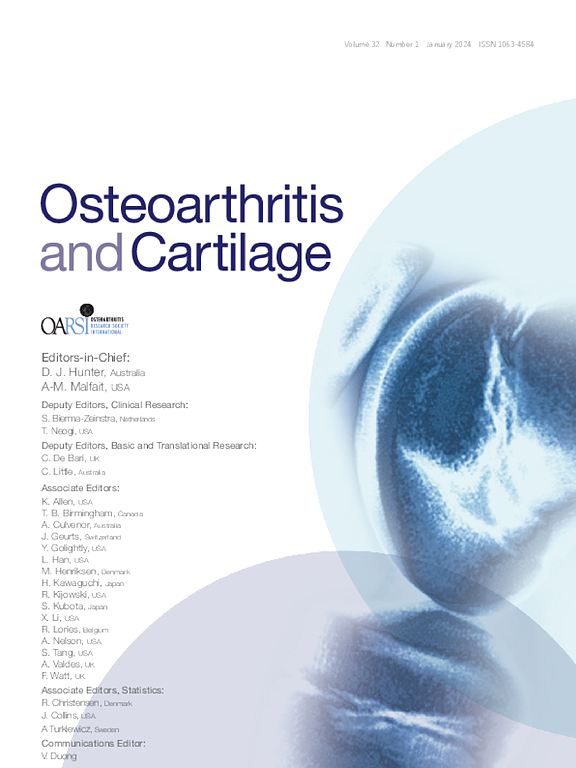使用抗组胺药和骨关节炎或关节疼痛
IF 7.2
2区 医学
Q1 ORTHOPEDICS
引用次数: 0
摘要
据报道,抗组胺药物可减轻骨关节炎患者的疼痛。我们的目的是估算抗组胺药的使用与以下三种结果之间的关系:骨关节炎的发病率、当前的关节疼痛以及骨关节炎的发展。本文章由计算机程序翻译,如有差异,请以英文原文为准。
Antihistamine use and osteoarthritis or joint pain
Objectives
Antihistamines have been reported to be linked with less pain in osteoarthritis. We aimed to estimate associations between antihistamine use and three outcomes: prevalent osteoarthritis, current joint pain, and developing osteoarthritis.
Methods
We included 25 003 participants of EpiHealth – a cohort of persons aged 45 to 75 from Malmö/Uppsala in Sweden. Participants self-reported the presence of allergy, joint pain and osteoarthritis at a study visit between years 2010 and 2016. Further, we obtained data about diagnoses of allergy and osteoarthritis from health-care registers (primary, specialist and inpatient care). Exposure was prescribed dispensed antihistamines (H1-antagonists) during ∼6 years preceding the EpiHealth visit retrieved from the Prescribed Drugs Register. The outcomes were osteoarthritis (any location), pain in knees/hips/hands-wrists at the examination (cross-sectional) and future incident diagnosis of osteoarthritis (longitudinal, in a cohort free of osteoarthritis at EpiHealth). We report risk ratios (95% confidence intervals [CI]) from logistic regression and hazard ratios (HR) from Cox regression, from models adjusted for age, sex, body mass index, allergy and use of healthcare. We used prescribed dispensed penicillin as negative control.
Results
The associations between use of antihistamines and osteoarthritis/joint pain at EpiHealth were 1.13 (95%CI 1.06, 1.20) and 1.02 (0.99, 1.05), respectively. The HR of future incident osteoarthritis diagnosis with use of antihistamines was 1.15 (1.03, 1.28). The association (HR) between penicillin use and future incident osteoarthritis diagnosis was 1.16 (1.07, 1.25).
Conclusions
In a large population-based observational cohort, use of antihistamines was neither associated with less joint pain/osteoarthritis nor lower risk of future osteoarthritis.
求助全文
通过发布文献求助,成功后即可免费获取论文全文。
去求助
来源期刊

Osteoarthritis and Cartilage
医学-风湿病学
CiteScore
11.70
自引率
7.10%
发文量
802
审稿时长
52 days
期刊介绍:
Osteoarthritis and Cartilage is the official journal of the Osteoarthritis Research Society International.
It is an international, multidisciplinary journal that disseminates information for the many kinds of specialists and practitioners concerned with osteoarthritis.
 求助内容:
求助内容: 应助结果提醒方式:
应助结果提醒方式:


